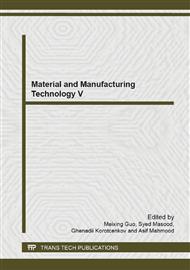p.136
p.141
p.147
p.152
p.157
p.162
p.169
p.174
p.179
Effect of Sintering Temperature on Dielectric Properties of CaCu3Ti4O12 Ceramics Prepared by Mechanochemical Process
Abstract:
CaCu3Ti4O12 (CCTO) is well known to have colossal dielectric constant in the range of 105.It is widely accepted that this phenomenon may be attributed to internal layer barrier capacitance (IBLC) model. The dielectric properties of CCTO were reported to be strongly dependent on the processing conditions and grain size. In this work, CCTO samples with different grain sizes were produced by varying sintering temperature in order to investigate IBLC effect on dielectric properties of CCTO. The samples were sintered at four different temperatures, (T=1100°C, 1050°C, 1000°C and 950°C). Dielectric measurements were carried out for the samples in the frequency range of 102 – 106Hz using impedance spectrometer. Electron micrographs showed that increasing temperature promoted the grain growth of CCTO while sintering. The internal crystalline defects are seen to play major role by increasing the grain conductivity in dipole formation and increased the dielectric constant of the samples.
Info:
Periodical:
Pages:
157-161
Citation:
Online since:
June 2014
Authors:
Keywords:
Price:
Сopyright:
© 2014 Trans Tech Publications Ltd. All Rights Reserved
Share:
Citation:


